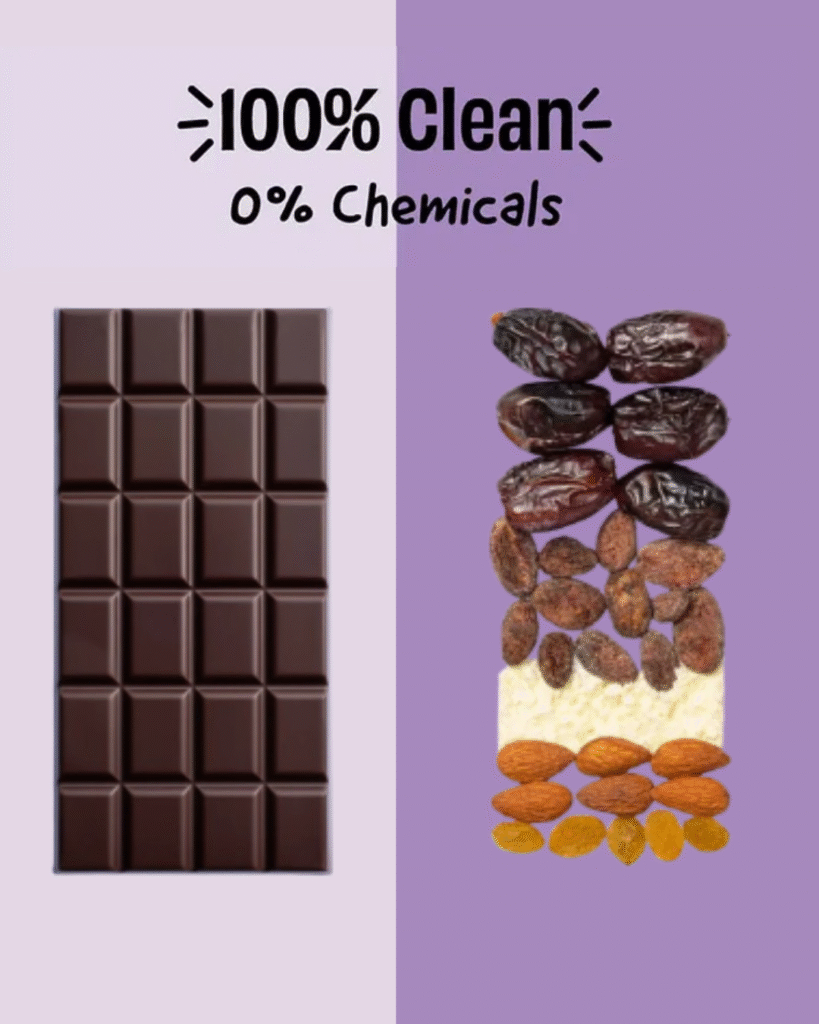Chocolate has always been a beloved indulgence across the world. From creamy milk chocolate bars to rich dark varieties, it’s a treat that never goes out of style. But in recent years, nut chocolate – a delicious combination of nuts and chocolate – has become increasingly popular. It’s not just about taste; many claim it’s the healthier choice compared to regular chocolate.
So, is nut chocolate truly better for you, or is it just another tasty trend? Let’s break it down.

1. Understanding the Basics:
Before we compare, let’s define what we mean by regular chocolate and nut chocolate.
- Regular Chocolate:
Usually made from cocoa solids, cocoa butter, sugar, and sometimes milk. It can be dark, milk, or white chocolate. - Nut Chocolate:
Regular chocolate (often dark or milk) combined with nuts such as almonds, cashews, walnuts, pistachios, or hazelnuts. The nuts can be whole, chopped, or ground into the chocolate.
While the base ingredient is still chocolate, adding nuts changes the nutritional profile significantly.
2. Nutrition Showdown:
| Feature | Regular Chocolate | Nut Chocolate |
|---|---|---|
| Calories | High (mostly from sugar & cocoa butter) | Slightly higher but with added protein & healthy fats |
| Protein | Low | Moderate (from nuts) |
| Healthy Fats | Minimal | Rich in monounsaturated & polyunsaturated fats |
| Fiber | Low | Higher (nuts add fiber) |
| Vitamins & Minerals | Some magnesium, iron | Higher in magnesium, vitamin E, potassium, and zinc |
| Sugar Content | Can be high, especially in milk chocolate | Slightly lower (depends on ratio), but nuts help slow sugar absorption |
Nut chocolate offers more protein, fiber, and healthy fats compared to plain chocolate, making it more satiating and nutrient-dense.
3. Health Benefits of Regular Chocolate:
Even plain chocolate has its health perks, especially dark chocolate with 70% or more cocoa:
- Rich in Antioxidants: Cocoa contains flavonoids that help fight oxidative stress.
- Heart Health: Moderate consumption may lower blood pressure and improve circulation.
- Mood Booster: Stimulates endorphin release, improving mood and reducing stress.
However, regular chocolate can also be high in sugar and calories, especially in milk and white varieties, which can lead to weight gain and blood sugar spikes if eaten excessively.
4. Health Benefits of Nut Chocolate:
When you add nuts to chocolate, you’re adding a host of additional benefits:
- Heart-Healthy Fats: Nuts like almonds and walnuts are rich in omega-3 fatty acids and monounsaturated fats, which support heart health.
- Protein Boost: Helps keep you fuller for longer, reducing unnecessary snacking.
- Fiber for Digestion: Aids in better digestion and helps stabilize blood sugar levels.
- Extra Vitamins & Minerals: Nuts are high in magnesium (good for muscles), vitamin E (skin health), and potassium (heart and blood pressure support).
- Slower Sugar Absorption: The fats and fiber in nuts help slow down the absorption of sugar from chocolate, preventing sudden spikes in blood sugar.
5. Skin, Brain, and Mood Benefits
Nut chocolate isn’t just good for your body – it benefits your skin and brain, too.
- Skin: Vitamin E in nuts and antioxidants in cocoa help protect skin from damage and keep it youthful.
- Brain: Healthy fats in nuts improve brain function and memory, while cocoa flavonoids boost blood flow to the brain.
- Mood: The combination of chocolate’s serotonin boost and nuts’ magnesium makes it a natural mood elevator.

6. The Satiety Factor – Feeling Full for Longer:
One of the main differences between nut chocolate and regular chocolate is how long they keep you satisfied.
- Regular chocolate may give you a quick energy boost but often leaves you craving more sugar.
- Nut chocolate, thanks to its healthy fats and protein, provides longer-lasting energy and helps you feel full longer, making it a better snack choice for those watching their appetite.
7. Which One is Better for Weight Management?
Weight management isn’t just about calories – it’s about how those calories affect your hunger and metabolism.
- Regular chocolate can be more calorie-dense from sugar without much nutritional value, leading to overeating.
- Nut chocolate may be slightly higher in calories, but it provides nutrient-rich calories that support overall health and help reduce cravings.
If eaten in moderation, nut chocolate can be a smarter choice for weight-conscious individuals.
8. The Taste Experience
Health aside, taste is a huge part of why we love chocolate. Nut chocolate offers:
- Crunch + Creaminess: The contrast between smooth chocolate and crunchy nuts is irresistible.
- Richness: Nuts add depth and complexity to the flavor.
- Variety: Almonds, cashews, pistachios, and hazelnuts each bring a unique taste profile.

9. Things to Watch Out For:
While nut chocolate is healthier, it’s still a treat:
- Portion Size: Nuts and chocolate are calorie-dense; stick to a small serving (20–30g).
- Added Sugar: Choose varieties with low sugar and high cocoa content.
- Quality of Nuts: Opt for dry-roasted or raw nuts over salted or fried ones.
10. Final conclusion – The Healthier Choice
If we compare nut chocolate and regular chocolate purely on health benefits, nut chocolate comes out ahead. The added protein, healthy fats, fiber, and micronutrients from nuts make it more nutritious and filling, while still delivering the rich taste chocolate lovers crave.
However, the healthiest option is dark nut chocolate with minimal sugar and high cocoa content. This way, you enjoy the best of both worlds – indulgence and wellness.